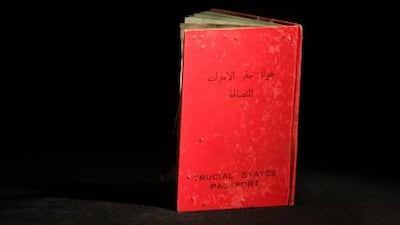Although he could not read it, Khalifa bin Qasmoul knew the single piece of paper he held in his hands was "priceless" and would define his place in the world.
"I was holding my identity - a proof of where I am from, regardless of where I went," Mr bin Qasmoul said.
Mr bin Qasmoul, who was born in 1945, has witnessed the evolution of his Emirati passport from a single sheet of paper to a standardised booklet, lined with the latest security features and a unique identification code.
Until the early 1940s, those who wanted to travel abroad would have to get a sheet of paper called a "certificate of identity", a substitute for a passport, from the British consulate in their emirate.
Printed in English, the paper would be signed by "British government in Trucial Oman", and would be accompanied by a photograph of the bearer, a physical description of the holder, such as eye colour and height, and the issue and expiry dates.
The paper's validity would be defined by a certain period and by which countries accepted it.
Some time later, each emirate began issuing its own passport, signed by the Ruler. It was at first a sheet of identity paper in Arabic, similar in form to that previously issued by the British.
"Before, we had to go to other countries, particularly other Gulf countries, to find work. And so we had to get passes and visas to go there," said Mr bin Qasmoul, who has held different jobs throughout his life, including as a labourer.
"Unlike now, it didn't matter what papers you carried. You were judged based on your work and integrity," he said. "We were all brothers, and the more prosperous countries accepted workers from the less prosperous countries."
Earlier visas would often be valid for up to six months and be limited to "Qatar, Bahrain, Kuwait and Saudi Arabia". Later, when the passports expanded into booklet form in the 1960s, the bearer could have a multiple entry visa that covered "All Arab countries, including India, Pakistan and Iran".
The passport would last up to two years.
An example of a 1960s Emirati passport can be seen at the Ajman National Museum. Enclosed in a glass display case is passport "no. 1", which belonged to the Ruler of Ajman, Sheikh Rashid bin Humaid Al Nuaimi (1928-1981).
With a reddish cover and 48 pages, the "government of Ajman and Dependencies" passport was issued on February 6, 1969. It was issued by the Ruler and signed by him too.
"To whom it may concern," the document states in Arabic and English. "Greetings, we request all concerned to allow the bearer of this passport to travel freely without let or hindrance and to afford him such assistance and protection as may be necessary."
The individual emirates continued to issue their own passports until the federation began on December 2, 1971. With the birth of the nation, one UAE passport was issued to all citizens. With a dark blue cover, it has 60 pages, each with an imprint of the national symbols, the falcon and the UAE flag.
More than 10 years ago, the passport got a new face. That is when the renowned Emirati calligrapher Mohammed Al Mandi used the "Thuluth" script on the cover to identify the UAE.
"I wanted our passport to stand out from the rest, and so I picked the script that looked the best with a long name like the UAE," said Mr Al Mandi, 51.
The Thuluth script appeared in the 9th century. It is also used in the Quran and is one of the more difficult and important ornamental scripts. It is often used in titles, headings and colophons - the imprints or emblems of publishers.
In addition to the local currency, Mr Al Mandi's calligraphy appears on the front of the Bahraini, Omani, Qatari and Kuwaiti passports.
"When I see people holding any of the passports I designed, I feel so proud and honoured, for it feels like one of my paintings in their hands, and it is travelling the world," he said.
Aside from the touch of classic art, UAE passports went high-tech when Berlin-based Bundesdruckerei signed on in 2009 to produce electronic passports for the UAE over the next five years. These passports are biometric IDs that comply with International Civil Aviation Organisation standards. Each has a computer chip in the cover, storing a facial image and two fingerprints from the holder.
The "UAE passport is one of strongest and most sought-after passports. It has come a long way", Mr Al Mandi said.

